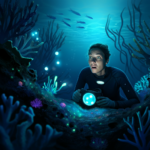When we think of dolphins, we picture graceful creatures leaping through waves, embodying elegance and freedom. But behind their sleek forms lies a profound intelligence that has fascinated marine biologists, nature enthusiasts, and science educators for decades. Dolphins, often referred to as the “Einsteins of the ocean,” have cognitive abilities that defy expectations, opening doors to understanding intelligence beyond humanity.
This blog explores what makes dolphins so intellectually remarkable, from their problem-solving capabilities to their complex social structures. We’ll also touch on ethical issues and the importance of protecting their habitats. By the end, you’ll see why dolphins are much more than just marine acrobats—they’re an essential reminder of nature’s brilliance.
The Intelligence of Dolphins
Unveiling Cognitive Mastery
Dolphins exhibit extraordinary intelligence, often drawing comparisons to humans. Research has shown that their brains are large and highly complex, with a neocortex that rivals that of humans in size and processing power. This part of the brain is responsible for higher-order functions such as problem-solving, self-awareness, and emotional regulation.
For example, dolphins have passed the “mirror test,” a widely recognized marker of self-awareness. When placed in front of a mirror, they exhibit signs of recognizing themselves, a trait shared only by a select few species like great apes and elephants.
Are They Smarter Than Us?
While direct comparisons between human and dolphin intelligence are admittedly challenging, dolphins display capabilities that bridge the gap between instinct-driven behaviour and thoughtful cognition. They excel in tasks requiring memory, mimicry, and teamwork. Multiple studies in captivity have demonstrated their ability to learn hand signals, understand abstract concepts, and even invent games.
Where humans rely on verbal and written language, dolphins rely on nuanced forms of communication and nonverbal problem-solving. Their intelligence may not be identical to ours, but it is undoubtedly complementary and equally remarkable.
Social Behavior and Communication
Complex Social Structures
Dolphins live in social groups called pods, forming tightly bonded communities that resemble human families. These pods work together to hunt, strategize, and protect each other. Some species, like bottlenose dolphins, even engage in alliances and coalitions, demonstrating their ability to cooperate in intricate ways.
Remarkably, dolphins also exhibit altruistic behaviours, often helping injured members of their own or even other species. Instances of dolphins rescuing humans from sharks or guiding stranded whales to safety highlight their capacity for empathy.
Language-like Communication
Dolphins communicate using clicks, whistles, and body movements. Recent studies suggest that their communication resembles a language, complete with distinct “signature whistles” that function as names. This shows an impressive understanding of individuality and identity within their social groups.
Furthermore, dolphins can learn to mimic human-created sounds and respond to complex commands, further solidifying their reputation as oceanic geniuses.
Problem-Solving and Tool Use
Crafty Innovators
One of the most remarkable traits of dolphins is their ability to use tools. For example, some dolphin species have been observed using marine sponges to protect their snouts while foraging on the ocean floor. This incredible behaviour showcases their innovative problem-solving abilities, as they not only use tools but also adapt them to their environment.
Learning from Experience
Research also shows that dolphins can learn from observation, a form of social learning rarely seen in non-human species. When one dolphin invents a new hunting technique, such as corralling fish into nets of mud, others in the pod quickly adopt the strategy. Such cultural transmission of knowledge suggests an advanced level of cognitive sophistication.
The Role of Play in Learning
Playful Yet Purposeful
For dolphins, play is more than just fun—it’s a critical part of learning. Juvenile dolphins are often seen engaging in playful behaviours such as chasing each other, riding waves, and tossing objects in the water. These activities not only strengthen social bonds but also help them practice key skills like coordination and problem-solving.
Creativity in Play
Interestingly, dolphins have been observed creating bubbles with their blowholes and then playing with them as though they were toys. This creative behaviour, which stretches beyond pure survival instincts, is a strong indicator of advanced cognitive abilities.
Conservation and Ethical Considerations
Saving the Einsteins of the Ocean
Despite their intelligence, dolphins face numerous threats, from habitat destruction to fishing nets and pollution. Climate change is also transforming their marine ecosystems, leaving them vulnerable to food shortages and rising ocean temperatures.
Conservation efforts are vital to ensuring their survival. Marine protected areas, sustainable fishing practices, and education campaigns are just some of the ways we can safeguard their future. Supporting organizations dedicated to preserving marine life is essential to sustaining dolphin populations.
Ethical Dilemmas in Study and Tourism
While studying dolphins has advanced our understanding of their intelligence, the ethical implications of captivity and human-dolphin interaction cannot be ignored. Dolphins in captivity often suffer from stress and limited socialization, which hinders their natural behaviours. As we continue to study these remarkable creatures, it is imperative to develop research practices that respect their well-being and prioritize their natural environments.
What Dolphins Teach Us About Nature’s Brilliance
Dolphins are more than just charming entertainers; they are intellectual and emotional beings that challenge our understanding of intelligence. From their intricate communication systems to their mastery of problem-solving, dolphins showcase the profound complexity of life beneath the waves.
Recognizing their value not only deepens our connection to the animal kingdom but also emphasizes the need to protect their habitats and ensure their survival for generations to come. If we continue to explore their world with compassion and curiosity, who knows what more we might learn from these extraordinary beings?
References and Further Reading
- Mann, Janet, et al., Cetacean Societies
- Marino, Lori, et al., “Mirror self-recognition in bottlenose dolphins”
- The Dolphin Communication Project, dolphincommunicationproject.org
- National Ocean Service, “Dolphin Social Structure”





















0 Comments